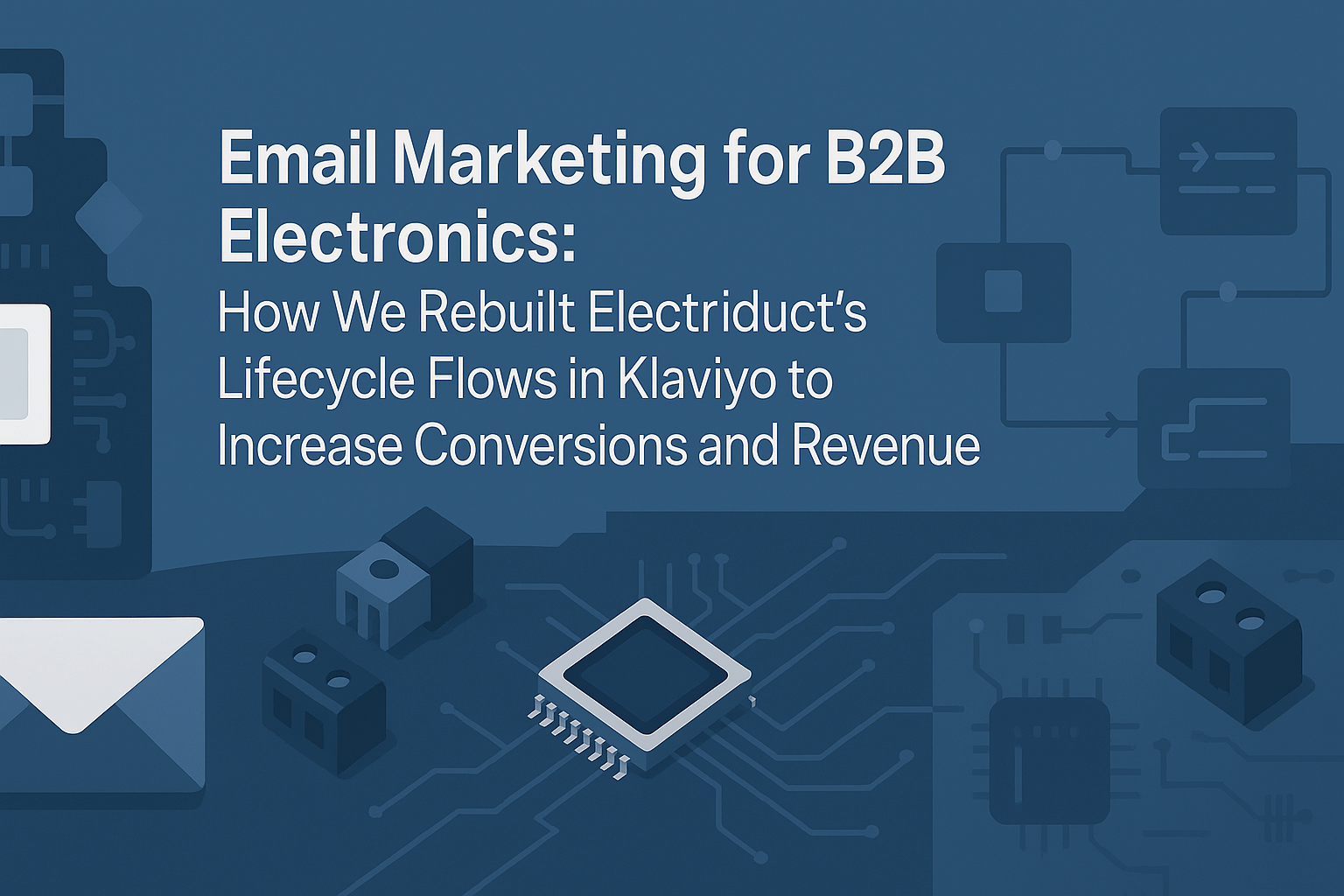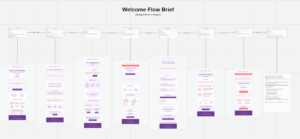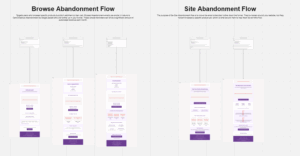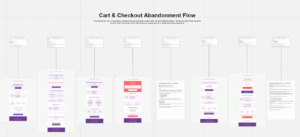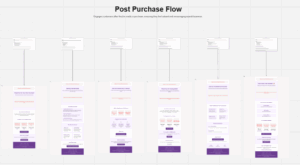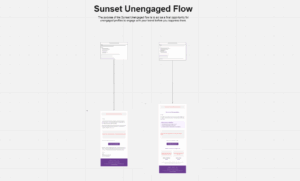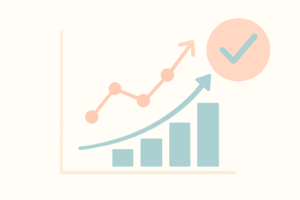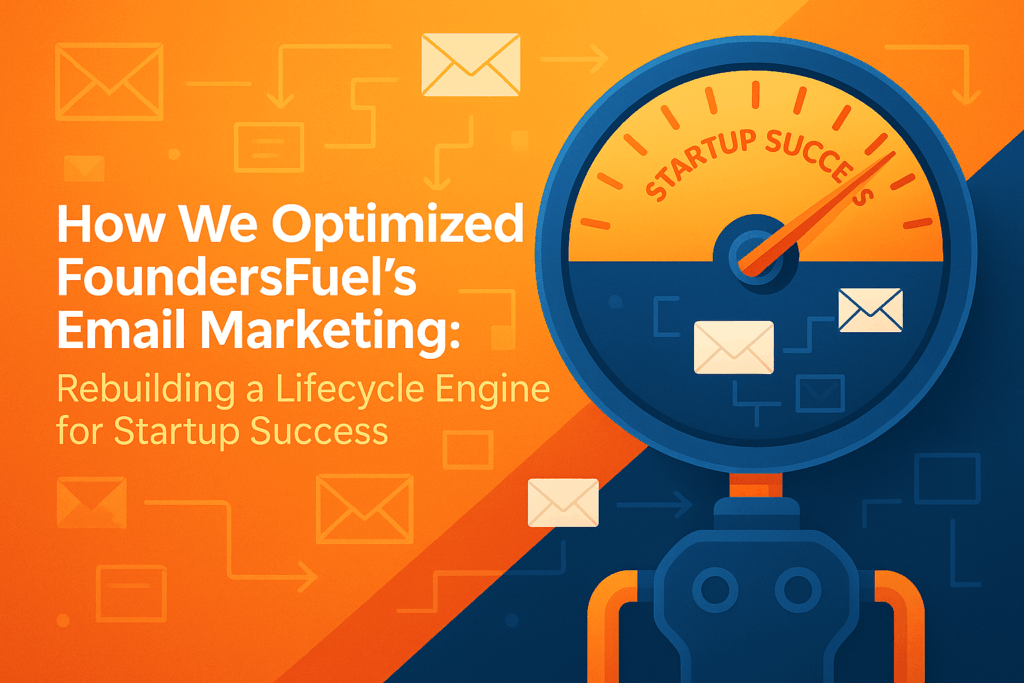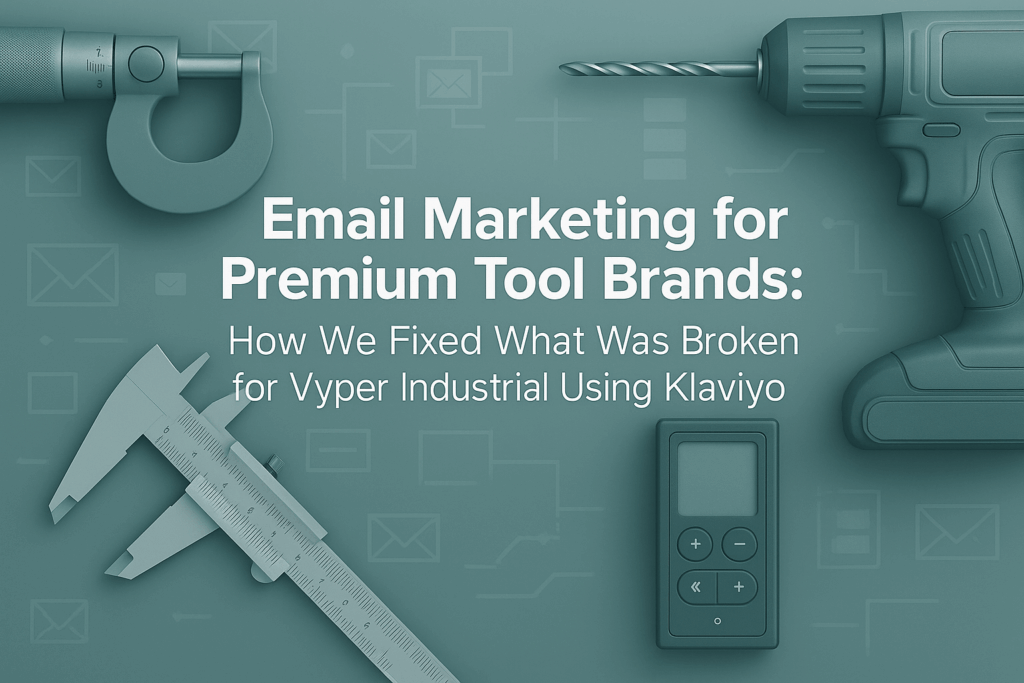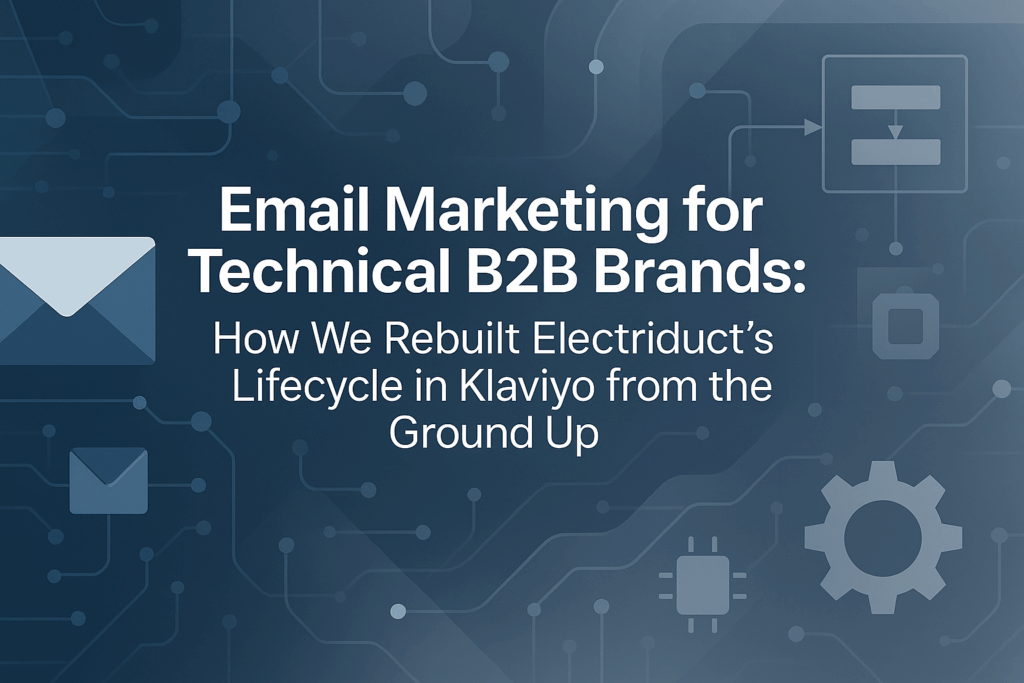Turning a Niche Product Into a Scalable Customer Journey
Electriduct has built its name in the world of cable management, a space where clarity, safety, and precision are non-negotiable. Their product catalog is massive, from heavy-duty cable ties to a full Neat Patch system, and their audience spans industries: IT teams organizing server rooms, construction managers securing high-voltage installations, and even residential customers hoping to keep their homes safe and organized.
The brand had the right ingredients: quality, reputation, and loyal customers. But their email marketing? It was underdeveloped. The strategy didn’t match the caliber of their product line or the technical knowledge of their buyers.
They weren’t alone. Many technical brands face the same disconnect: they invest heavily in product design and customer support, but their communication feels transactional, one-size-fits-all, and reactive.
When Electriduct approached us, they weren’t looking for a few flashy campaigns. They needed an entire email system, one that could nurture relationships, reinforce technical trust, and turn passive browsing into confident buying. Our goal was to transform email from a static reminder tool into a fully integrated revenue driver.
So we built seven lifecycle flows, 34 emails total. Each one is designed with Electriduct’s voice, buyers, and product complexities in mind. Here’s how we rebuilt their email marketing from the ground up and made it work just as hard as their products do.
Welcome Flow Optimization: First Impressions That Build Long-Term Trust
For a brand like Electriduct, the welcome experience sets the tone. These emails weren’t just about first purchases, they were about building credibility in a technical category where every detail matters. Our goal is to create a sequence that educates, earns trust, and converts without ever sounding like a sales pitch.
1. Welcome to Electriduct Here’s How We Help You Work Cleaner and Smarter
This opening message keeps things crisp and confident. We introduced Electriduct not with a wall of text but with a bold visual: clean cable management in action. The subject line (“Welcome to Electriduct, Your 15% Off Code is Inside”) delivers value upfront.
The body of the email leads with clarity: who we are, what we offer, and why it matters. A 15% welcome discount is tucked beneath a clean product navigation, driving users to explore. It’s simple, fast-loading, and mobile-optimized because we know many users are opening from job sites or on the go.
2. The Story Behind the Brand
We brought in warmth and credibility by sharing the “why” behind Electriduct, not just what they sell, but why they exist. We talked about solving cable clutter in complex environments, about listening to IT teams and electricians, and about designing products that outlast their environments.
We used a professional but personal tone with visuals of actual installations in real customer environments, signaling trust and relevance.
3. Explore Our Most Trusted Solutions
Now that we had their attention, we shifted focus to product education. This email introduces Electriduct’s bestsellers, but it doesn’t feel like a catalog. Instead, each item is introduced with a “why this matters” lens, UV-resistant ties for outdoor installs, patch panels designed for airflow, etc.
Short descriptions. Strong benefits. Technical accuracy. And every product featured was available for quick buy, with no friction, no overwhelm.
4. Don’t Let Your 15% Discount Go to Waste
A gentle nudge, not a scream. This reminder email reintroduced the discount code with a countdown and subtle urgency. We used testimonials from IT managers and facility supervisors who echoed a single truth: “I should’ve upgraded my setup months ago.”
The design: focused. A countdown bar up top, one featured product, and a CTA below. No clutter. Just clarity.
5. What Makes Electriduct Different?
Instead of buzzwords, we led with side-by-side product comparisons: our materials vs. theirs, our warranties vs. theirs, our innovation cycles vs. generic suppliers. For professionals who’ve been burned by cheap products, this was the turning point. “Better” wasn’t just said it was proven.
6. Real Customers. Real Results.
From warehouses to data centers, we showcased real customer installs. But we let them tell the story: quotes about performance, ease of install, safety improvements. The layout: clean testimonials segmented by use case, each with a link to shop the featured product.
It didn’t just build trust, it built aspiration.
7. Last Chance to Use Your 15% Code
No tricks here. Just a respectful final reminder before the code expires. We reiterated the brand values, recapped the top benefits, and kept it tight. A subtle countdown. A big orange CTA.
For buyers who needed a final push, this was the moment.
8. A Note from Our Founder
This one is written in plain text. First-name sender. No images. Just a short, personal thank-you from Electriduct’s founder. We used this as a moment to pause the marketing and build a human connection.
It closed the sequence with grace and left the door open even if the subscriber wasn’t ready to buy yet.
Why This Flow Works
This welcome sequence avoids what so many technical brands get wrong: rushing the sale. Instead, it builds understanding first, trust second, and only then nudges action. Every email is shaped around the user’s mindset: education, not just persuasion. The product isn’t just positioned as “useful,” it’s positioned as the industry standard. For Electriduct’s audience of smart, busy professionals, that’s the key. They don’t want to be sold. They want to be shown.
Abandonment Flows: Re-Engaging Technical Buyers Without the Hard Sell
Electriduct’s customers don’t make decisions on a whim. They’re spec-driven, budget-conscious professionals, and that means abandonment isn’t indecision, it’s research. Our abandonment flows were designed not to “win them back” with gimmicks, but to support their process, answer their questions, and give them reasons to return when they’re ready.
Site Abandonment Flow (2 Emails)
1. A Smart Place to Start
This first message was built around gentle re-introduction. The subject line? “Still exploring cable management options?” The content offered a curated guide titled “Top Solutions by Industry,” helping the reader self-identify with a path: IT, construction, home improvement, etc.
No hard CTA. Just an offer to explore segmented intelligently based on their behavior and entry point.
2. Products Built for Your Environment
This follow-up focused on relevance. We featured Electriduct’s top-performing categories, but each one came with a use-case label: “For Data Centers,” “For Outdoor Jobsites,” “For Home Studios.” The email also included testimonials from industry peers, with a short line about what problem Electriduct helped solve.
This wasn’t about showcasing SKUs, it was about positioning solutions in the context of real-world work.
Browse Abandonment Flow (3 Emails)
1. Dive Deeper Into What You Were Viewing
If someone had looked at a specific product or category, we followed up with a focused technical breakdown. Not fluff real details: tensile strength, temperature tolerance, materials certifications.
We also layered in “What Pros Are Saying” short testimonials that aligned with the customer’s profile, such as “Easy to install and still strong after 2 years outdoors – IT Manager, Phoenix.”
The CTA? “See Specs Again.” We weren’t closing, we were educating.
2. Here’s How Others Are Using It
For Electriduct, showing a product in use builds more confidence than describing it in a vacuum. This email featured three quick case studies, one from an AV installer, one from a facility manager, and one from a residential electrician, each using the product the visitor had viewed.
Each mini story included a visual and a line about how the product helped, “Cleaned up 17 server racks in under 3 hours” or “Reduced trip hazards on a crowded jobsite.” These weren’t made-up marketing lines, they were real pull quotes from Electriduct’s reviews.
3. Have a Few Final Questions?
This one was a trust builder. It opened with a question: “Still wondering if this fits your setup?” Below that, we featured a short FAQ, preloaded with answers about compatibility, installation time, and durability.
We also added a “Talk to a Specialist” button routed directly to Electriduct’s customer support with the line, “We’re happy to spec out a solution, no pressure.”
To add incentive without undercutting brand value, we offered free shipping for 72 hours. Not a discount. Just help.
Why This Flow Works
This abandonment system teaches. Every email respects the buyer’s timeline and offers something useful: a guide, a case study, or a spec sheet. We don’t manufacture urgency. We manufacture clarity. That’s the shift.
These flows work because:
- They treat hesitations as normal, not as failures
- They deliver specifics, not just reminders
- They align with the buying behavior of technical professionals
- They don’t break brand trust with gimmicks or pressure
In a market full of discount pop-ups and aggressive follow-ups, Electriduct’s approach stands out: intelligent, useful, and on-brand.
Cart & Checkout Flow: Supporting Considered Purchases with Substance
Abandoned carts aren’t signs of failure, especially for Electriduct. They are pauses. They reflect real-world factors: spec checks, budget approvals, cross-department sign-offs. So instead of hammering reminders, we built a cart flow that helps buyers keep moving forward calmly, confidently, and with the information they need to finish the job.
1. You Left Something in the Works
This was a simple, non-intrusive re-entry. We used real product photos, pulled spec details like tensile strength and dimensions, and avoided clutter. The tone was direct but respectful: “It looks like you were building a solution. Still need it?” Below the cart summary, we placed a big, clear CTA: “Return to Cart.” Nothing flashy. Just an easy way back.
2. Your Specs, Answered
Here we anticipated the common questions that often delay checkout: installation details, environmental ratings, compatibility, and support. The copy read more like a help doc than a sales email. For example: “Yes, the UL-listed ties are rated for indoor/outdoor use even in Florida humidity.”
We also included a contact button labeled “Still Unsure? Ask Our Product Specialist.” Because at this stage, the customer might need a human, not another push.
3. See How Others Solved It
To add social context, we brought in 2 mini-case studies, both specific to the products in the abandoned cart. Each one included a visual and a short quote like: “Our site was a mess. These ties held strong all winter, and they made inspection day a breeze.”
This wasn’t vague proof; it was peer reinforcement tailored to the customer’s industry.
4. Build the Full Setup
Many abandoned carts were incomplete solutions. If someone had a cable tray but no mounts or a cover with no adhesives, this email offered a curated list of add-ons. Not upsells, just what they were likely missing. The layout showed compatibility clearly and visually.
5. Free Shipping on Us (For Now)
We avoided broad discounts but offered a value-based nudge: “Complete your order in the next 72 hours and shipping’s on us.” The tone was matter-of-fact. No bold red countdown timers, just a well-positioned benefit framed as appreciation for their consideration.
6. Why Electriduct Wins
Here, we leaned into differentiation, not hype, but head-to-head comparisons. We included a spec table: ours vs “most cable ties.” Things like tensile rating, flame resistance, and UV stabilization. Side-by-side, no fluff.
This email helped buyers justify their choice, internally often necessary in technical procurement.
7. Your Cart, Your Timeline
This message acknowledged that some carts take longer. The subject: “Still in Review?” The copy: “We get it. You’ve got specs to check and approvals to run through. That’s why we’re holding your cart a bit longer.”
It wasn’t pushing, it was buying them time.
8. Just Checking In Need Help?
The final email came from a real person, an Electriduct account manager. Short, plain text, no template: “Hi , saw you were building out a solution last week. Want me to take a quick look with you?” It included a direct reply-to address, not a form.
It ended with: “Even if you’re not ready to move forward, happy to answer any last questions.”
Why This Flow Works
This cart recovery flow was built for professionals, not impulse shoppers. Electriduct’s customers don’t abandon carts because they’re unsure—they pause to check specs, confirm fit, or wait on internal approvals. So we didn’t chase them with urgency. We gave them what they actually needed: technical clarity, peer proof, and a direct path back. Each email delivers one clear function—answer a question, confirm a spec, or show how others solved the same problem. The pacing mirrors real decision cycles. No pressure. No gimmicks. And the final message doesn’t come from a promo—it comes from a person. In this space, helping someone finish their order isn’t about persuasion. It’s about removing friction.
Clarifying the Path: Turning Post-Purchase Silence into a Relationship
Buying from Electriduct is just the beginning. Whether it’s a single order of ties or an entire system rollout, the post-purchase moment is critical. It’s when expectations are highest. It’s when support matters most. And it’s when trust either deepens or dissolves.
This flow was designed to meet customers right there with clarity, with utility, and with momentum.
1. Your Order Is In Here’s What’s Next
The moment the order’s placed, we set expectations clearly. This wasn’t just a “thanks” email it was a launchpad. We included:
- A confirmation summary with SKUs, quantities, and images
- A visual map of the delivery timeline
- A “Get the Most from Your Order” link to install guides and technical sheets
The tone? Professional, but personable. Not “corporate cold.” Just clear.
2. Shipping Out With Setup Tips
When the package leaves the warehouse, this email goes out. But we didn’t just say “your order’s shipped.” We said: “It’s on the way and here’s how to prep.”
For Neat Patch trays? We linked to videos. For heavy-duty ties? We shared temperature best practices. For adhesives? Cure time tips.
The goal: make their unboxing useful, not uncertain.
3. Check-In and Support
Sent 3 days after delivery, this email asked one thing: “Everything going smoothly?” We positioned it as a support touchpoint, not a feedback form. The CTA? Need Help? Talk to a Product Specialist.”
We also linked to the FAQs based on the specific products they ordered. No guesswork.
This was about showing up, not disappearing.
4. Would You Recommend Us?
Once customers had time to use the product, we asked for feedback. But we framed it in a way that respected their expertise: “What did you think of the installation process?” and “How’s it performing in your environment?”
We avoided stars. Instead, we made it feel like their technical insight could help others like them.
And it often did.
5. Complete Your Setup
This email wasn’t a hard sell. It was a systems-thinking nudge. “If you’re running cable trays, here’s how to protect, label, and expand.” For each recent purchase, we matched it to logical next steps.
The layout included bundle visualizations and compatibility callouts a “what’s next” guide disguised as helpful planning.
6. Loyalty Program Introduction
Thirty days later, we introduced the loyalty program. But we did it differently. We calculated their current point total based on what they’d already purchased. So the message was: “You’ve already earned this, here’s how to use it.”
No empty promises. Just a continuation of value.
Why This Flow Works
This flow isn’t about squeezing another sale out of a customer who just checked out. It’s about making them feel sure—sure they made the right decision, sure they’re in good hands, and sure they’re not just another order number. That matters, especially when you’re selling something technical, where trust doesn’t come easily. The timing is intentional: emails land when the order’s placed, when it ships, when it arrives—removing the guesswork and reducing those silent moments where doubt can creep in. It walks them through setup, shows them how others are using the product, and turns what could’ve been a lonely “now what?” into a confident “I’ve got this.” And when it asks for a review, it doesn’t beg. It makes the customer feel like their insight actually matters. No fluff, no pressure—just a smooth transition from buyer to believer.
Customer Retention Flows: Rebuilding Engagement or Letting Go with Grace
Long-term loyalty isn’t automatic, especially in technical industries where buyers often order in cycles or when specific projects arise. That’s why retention for Electriduct had to be intentional. The goal? Keep the brand top-of-mind, re-engage when the time is right, and cleanly exit when it’s not.
We built two flows to support this: a Winback system for dormant customers and a Sunset system for disengaged subscribers.
The Winback Flow: Earning the Return, Not Just Asking for It (5 Emails)
This 5-part sequence was built to reawaken interest after 90+ days of inactivity, whether due to project lull, switching suppliers, or simply forgetting.
Each email was matched to behavior (what they last bought, how they last engaged) and approached the customer not with desperation, but with relevance and restraint.
1. “What’s Changed Since You Last Ordered?”
We opened the conversation with a tone of useful curiosity. No heavy pitc,h just a simple message:
“You ordered a few months ago. Since then, we’ve updated our inventory, released new specs, and improved performance on a few tools.”
This email included a personalized recap of their last order and 2–3 new recommendations based on related SKUs or upgrades.
2. “Here’s What’s Working for Teams Like Yours”
Segmented by industry (IT, Construction, Facilities), this message delivered quick case studies from real professionals.
The tone? You’re not alone. Other teams are solving similar problems, and here’s what they’re using now.
This helped create relevance without selling. It reconnected customers to how Electriduct fits into their workflow, not just their budget.
3. “Thanks for Being a Customer Here’s Something Extra”
This was our soft offer: 10% off their next order or a free accessory kit with a qualifying purchase. We framed it not as a coupon, but as a loyalty gesture.
No countdown. No yelling. Just: “We’d love to support your next project.”
4. “Let’s Solve That Next Problem”
This one leaned into technical education. It offered troubleshooting tips, installation hacks, and overlooked accessories that could help them take their setup to the next level.
Even if the reader wasn’t ready to buy, the email delivered value, which earned future mindshare.
5. A Direct Note from the Team
This plain-text message came from an Electriduct account manager. It was honest:
“If there’s a reason you haven’t come back, let us know. If there’s something we can help wit,h we’re here.”
This closing note opened the door for feedback and gave customers a low-pressure way back in.
Why This Flow Works
This winback flow doesn’t come in with desperation. It doesn’t flood inboxes with discounts or try to guilt customers into returning. Instead, it operates on a simple belief: if someone stopped buying, there’s a reason—and it’s worth understanding. That mindset shifts everything. The timing is respectful, never aggressive. The content leads with updates, helpful tools, and real value, because not every customer is ready to buy, but many still want to feel informed. Most importantly, the tone feels like a person reaching out, not a bot on a schedule. It sounds like Electriduct—clear, useful, no fluff. And for a brand that supports project-based work, that matters. Some customers don’t reorder because the job’s done. But when the next one comes around, they’ll remember the supplier who treated them like a partner, not just a line item.
The Sunset Flow: Saying Goodbye with Professionalism (2 Emails)
Sometimes, silence means it’s time to move on. Electriduct’s Sunset Flow helps clean the list, but it also gives disengaged subscribers one last, thoughtful chance to stay.
1. “Still Want to Hear from Us?”
This email showed up after six months of no activity. But instead of guilt-tripping the subscriber, it gave them three easy options:
- Yes, keep me subscribed
- I want fewer emails
- No, unsubscribe me
We also included a quick recap of what they’ve missed new products, customer stories, and helpful tools.
The tone? “We value your time. Let’s make sure this is still helpful.”
2. One Last Nudge Before Goodbye
The second and final email reiterated the choice with clarity and honesty:
“If we don’t hear from you, we’ll remove you from our list to respect your inbox.”
We included a simple parting message from the brand thanking them for being part of the community, and reminding them they’re always welcome back.
Why This Flow Works
Electriduct doesn’t believe in ghosting customers—or spamming them into oblivion. If someone’s gone quiet, this flow doesn’t take it personally. It steps in with honesty, not pressure. It gives people a choice: stay connected or step away, no hard feelings. That kind of clarity isn’t just polite—it’s professional. It shows the brand respects time, attention, and inbox space. And in doing so, it protects how Electriduct is remembered. The emails don’t beg. They don’t chase. They simply say, “We noticed. We care. You’re in control.” That soft close builds more trust than any discount ever could. And by letting go of disengaged contacts with care, the brand keeps its list clean—and its voice heard by the people who actually want to listen.
Strategy & Implementation: Building an Email System, Not Just Emails
We didn’t just write 34 emails. We built a revenue system.
Most brands treat email as a series of tactics: write some copy, plug in a discount, hit send. Electriduct took a different route. Together, we built an entire lifecycle architecture—designed to earn trust, teach before it sells, and scale without losing voice or relevance.
Customer-Led Research & Journey Mapping
Before a single subject line was written, we went to the source. IT managers, project leads, facility engineers—we asked what slows their buying process, what builds trust, and what turns them off. Then we audited every existing touchpoint and saw the problem clearly: isolated blasts, no lifecycle strategy. From there, we mapped a full journey: from first click to repeat purchase.
Content Architecture & Message Strategy
We didn’t write “emails.” We assigned jobs. Each flow had a customer outcome, not a marketing goal:
- Welcome: “Show me I’m in the right place.”
- Cart: “Help me justify this purchase.”
- Winback: “Remind me why you mattered.”
That mindset shaped every message. No fluff, no filler—just utility and relevance. Product specs were vetted by engineers. One wrong stat could cost trust. We didn’t let that happen.
Design System & Technical Infrastructure
We built a design system, not just templates. Modular blocks—spec tables, testimonial grids, feature comparisons—let Electriduct scale future sends without reinventing the wheel. On the backend, we wired up Klaviyo with behavioral triggers, conditional content, and dynamic population tied to product category, use case, and lifecycle stage.
Testing, Launch & Lifecycle Optimization
We launched flows sequentially, tracked fall-off points, refined segmentation, and adjusted timelines based on decision cycles. This wasn’t vanity metric chasing. It was behavioral intelligence in motion.
Why This Strategy Works
This system isn’t stitched together. It moves. It thinks. It earns trust by behaving like the buyers it serves—clear, capable, and deliberate. And like Electriduct’s own product line, it wasn’t built to be flashy. It was built to last.
Expected Results & Conclusion: Turning Communication Into Conversion
Most email systems in B2B are forgettable. They chase clicks, recycle templates, and hope timing does the heavy lifting. Electriduct’s old setup wasn’t broken—it just wasn’t helping. Emails were going out, but nothing was really landing. No journey. No clarity. No system.
That’s what we rebuilt.
Now, with the full lifecycle framework in place—built around behavior, trust, and timing—the system is live, and early signals are promising. Based on initial engagement trends, A/B tests, and benchmarks from similar rollouts, here’s what we expect Electriduct to see as the new flows take hold:
Projected Performance Gains (Based on Testing + Benchmarks)
- Email-attributed revenue projected to increase by 35–45%
- Average order value from email expected to lift 15–20%
- Repeat purchase rate anticipated to climb by 25–30%
- Welcome flow conversion estimated at 12–15% from subscriber to customer
- Cart recovery conversions projected at 15–20% (up from ~5%)
- Browse abandonment follow-up expected to convert at 8–10%
- Open rates across flows aiming for 30–40% (vs. baseline of 18%)
- Click-through rates targeting 8–12%
- List health expected to improve, with unsubscribe rates cut in half
- Overall customer LTV forecasted to grow by 25–30%
But we’re not watching numbers for their own sake. We’re watching behavior.
We’re watching how customers respond when emails finally speak their language. We’re seeing replies to automated flows. More confident conversions. Fewer abandoned carts that stay abandoned. Fewer support questions that should’ve been answered upstream. And a tone of voice that finally feels like the brand.
The real goal wasn’t better metrics. It was a better relationship. Numbers are just how we track if we’re earning them.
Because for a technical brand like Electriduct, trust isn’t won with a flash sale—it’s won with clarity. With follow-through. With systems that serve the buyer, not just the marketer.
If you’re still sending emails as reminders instead of relationship builders, the gap isn’t just tactical. It’s structural. And it’s costing you.
This is what it looks like to fix it.
From Passive Channel to Performance Engine
Most brands see email as a necessary chore. Electriduct now sees it as a competitive advantage.
This isn’t just a new marketing channel. It’s a system that sells while teaching. It supports before converting. It explains before it asks. And most importantly it builds a digital experience that feels as engineered as the products they sell.
If you’re a product-led brand with a technical audience and a high bar for trust, this kind of email marketing isn’t optional anymore. It’s foundational.
Want to build a lifecycle system that earns revenue and respect?
Contact Us. Let’s talk about what your version of Electriduct looks like.



